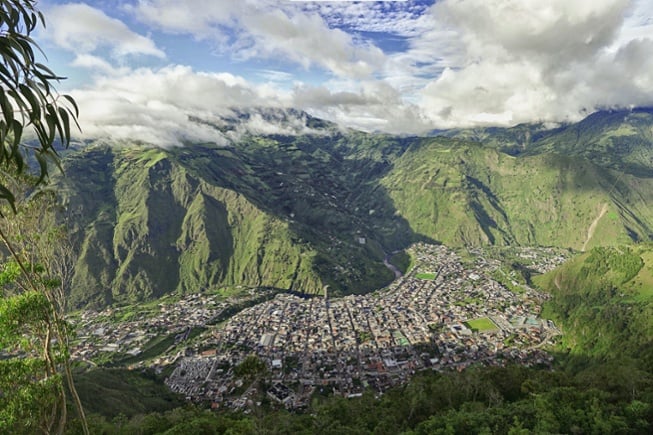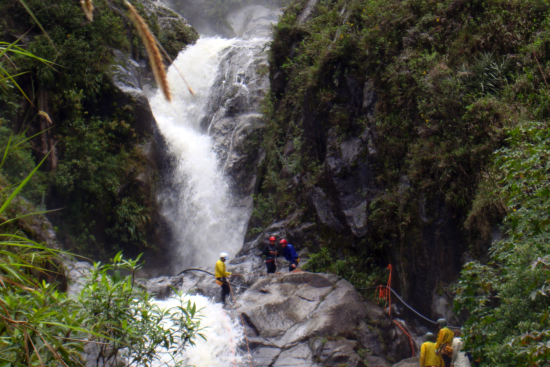Baños, Ecuador
Located at the foot of the Tungurahua volcano, Baños, Ecuador is often referred to as the "Gateway to the Amazon."

About Baños
Nestled in central Ecuador, the town of Baños is appropriately named for its dozens of waterfalls, hot springs, and surrounding rivers. It is a naturally beautiful town with a population of less than 20,000, a pleasant climate year-round, and an ancient affinity for miracles. The town’s full name is Baños de Agua Santa, or “Baths of Sacred Water.”
Baños sits at the foot of the Tungurahua volcano, which has been steadily flowing hot lava and ash since a big eruption in 1999. Also known as the “Gateway to the Amazon,” Baños is the starting point to explore surrounding national parks, spectacular volcanoes, and an abundance of wildlife including llamas and vicuñas.
In the last few years, Baños has grown into a popular destination for extreme sport aficionados, and is an excellent stopping point for those wishing to relax in the many thermal baths, taste the famous melcocha taffy, and experience the mysticism this quaint town has to offer.
Things to Do in Baños

- Mountain bike the road to Puyo. You’ll traverse through tunnels, overhangs, and suspension bridges on the road from Baños to Puyo. For most of the journey, the “Road to Puyo” is narrow, winding, and fast, with no shoulders and few guardrails – enough to satisfy any risk-taker.
- Bathe in the local hot springs. There are plenty of them, ranging from public bath houses to spas, the latter of which are more catered to the international visitor. Locals prefer the public hot springs. All the springs’ water contain a high mineral content abundant with restorative and healing properties. And fortunately, most of the baths are in walking distance from downtown.
- Horseback ride or hike in the Andean hills, and explore the surrounding countryside.
- Raft the Pastaza River. The Pastaza and Patate Rivers offer Class III and IV whitewater rafting. Just be sure to check for rough conditions before you go!
- Visit the famous basilica dedicated to Nuestra Señora de Agua Santa, or “Our Lady (the Virgin Mary) of Holy Water.” The basilica was built at the turn of the last century from volcanic rock sourced near Tungurahua. The Virgin is credited with many miracles in the area, and it is said she appears by the waterfalls from time to time. The neo-gothic interior of the basilica is decorated with her stories and the site is a pilgrimage for those wishing to thank the Virgin for her many miracles.
- Taste the melcocha, and watch how this sweet taffy is made from sugar cane. In most mom-and-pop shops, visitors can watch the melcocha artisans wrap the taffy around a wooden peg on the inside of a door frame, and repeatedly beat and stretch the taffy into perfection. Try it fresh off the peg, but beware, some melcochais very tough and not for the weak-toothed.
- Rent an ATV (all terrain vehicle) and hit the trails.
- Explore Llanganates National Park. Considered one of the most diverse ecosystems in the world, Llanganates is divided into two regions – the dry, high-elevation Andean side to the east, and the more lush and wet Amazonian side to the west. Spectacled bear, alpacas, and condors are often seen roaming in the park, and the mountains here are thick with cedar and cinnamon trees.
- Hike Cerro Hermoso. Don’t be deceived by almost 15,000 ft. of elevation – Cerro Hermoso is one of the more manageable peaks to mount, and is a popular 4-day trek for those aspiring to conquer the highest peak in the mysterious Llanganates mountain range. Backpackers usually hire a guide, as getting lost is all too easy.
- Canyon down one of Baños’ several dozen waterfalls, including Manto de la Novia, Pailón del Diablo, or Cashaurco.
- Rockclimb. For an adventure with a view, there a few places outside of Baños to scale some vertical terrain. Or test your skills at the local indoor rock wall first.
- Take in the views of Tungurahua. The disaster in October 1999, and subsequent, frequent, eruptions have discouraged hikers from ascending the 16,452 ft. of elevation. For those not willing to take the risk, walk to Luna Runtún Spa on the hillside or take a cab out of town for a more brilliant view of the ash and lava, which is very much alive, and erupting today. Tungurahua is a Quechua name meaning “throat of fire.”

There are many places to stay, including quaint cottages, residences with a local family, and upscale hotels, all of which are well accustomed to catering to visitors’ differing needs. And after a long day, the restaurants of Baños are adept at serving up delicious Ecuadorian and international cuisine.
Stay Connected to Our Work
Get a digest of Pachamama Alliance news, events, and resources in your inbox every other month, plus breaking news about our work.